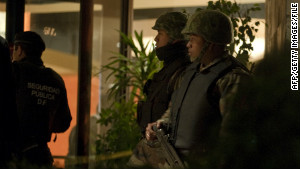Mexico City (CNN) -- Near the ruins of an ancient Aztec temple, a woman shouting into a microphone claims Mexican society is crumbling.
"We are no longer free to walk in the streets because of what is happening," she yells.
Demonstrators behind her tape cardboard crosses to a fence in front of Mexico's National Palace. The names of slaying victims are scrawled with black magic marker on each one.
"I want the impunity to end," a leftist lawmaker says, blaming Mexican President Felipe Calderon's five-year-long crackdown on drug cartels for the surge in violence.
A handful of people clap. But throngs walk through Mexico City's massive central square without glancing in his direction.
In this sprawling metropolis, the brutal conflicts between drug cartels and government troops are both strangely absent and omnipresent. They are nowhere to be found and everywhere you look.
At a corner newsstand, the front page of a paper shows a dead man lying in a pool of blood. The cover of a magazine pictures people praying at a funeral.
At an airport gift shop, a book about beauty queens in the drug trade is only steps away from bottles of tequila and souvenir sombreros.

From the halls of his official residence here, President Calderon announced plans in late 2006 to deploy troops in a nationwide crackdown on drug cartels.
Here, too, a peace movement led by a poet whose son was slain has taken root, with protesters staging "caravan" demonstrations that go from the city's central square to some of the country's most violent areas.
But the gun battles, mass graves and fiery road blockades in other parts of the country aren't part of daily life in Mexico's capital.
Organ grinders, food vendors and street performers play to a constant stream of people who flood the sidewalks.
The city, once dogged by a reputation for being crime-ridden, has become a refuge.
"Just a decade ago people in Mexico City would say they wanted to leave and live in the surrounding states to have a more peaceful life. Today, paradoxically, Mexico City has become one of the safest places to live," Mexico City lawmaker Lizbeth Eugenia Rosas Montero said at a recent government meeting. "Now the people who live in the states spend their vacations in the capital to be away from the shootouts, kidnappings and executions."
But crime still creeps in to the heavily policed capital.
The densely populated city and surrounding state of Mexico are profitable turf for drug dealers. Local gangs fighting over sales fuel most drug-related violence there, says Ana Maria Salazar, a former Pentagon counternarcotics official who lives in Mexico City and hosts a weekly television program on the country's security issues..
Murder rates in Mexico's capital are half the national rate of 18 per 100,000 residents, and are lower than homicide rates in U.S. cities like New Orleans and Washington. But that hasn't stifled fears that something bigger could be brewing.
The city saw more than 120 killings related to organized crime between January and September last year, according to Mexico's Attorney General's Office. In the neighboring state of Mexico, the number was much higher, nearly 600.
"Mexico City, for whatever reason, has not been a battleground," Salazar says. "It could very easily become that."
Finding comfort in the chaos
Julia Alonso crammed as much as she could into a suitcase and headed for Mexico City last year.
Source-cnn



No comments:
Post a Comment